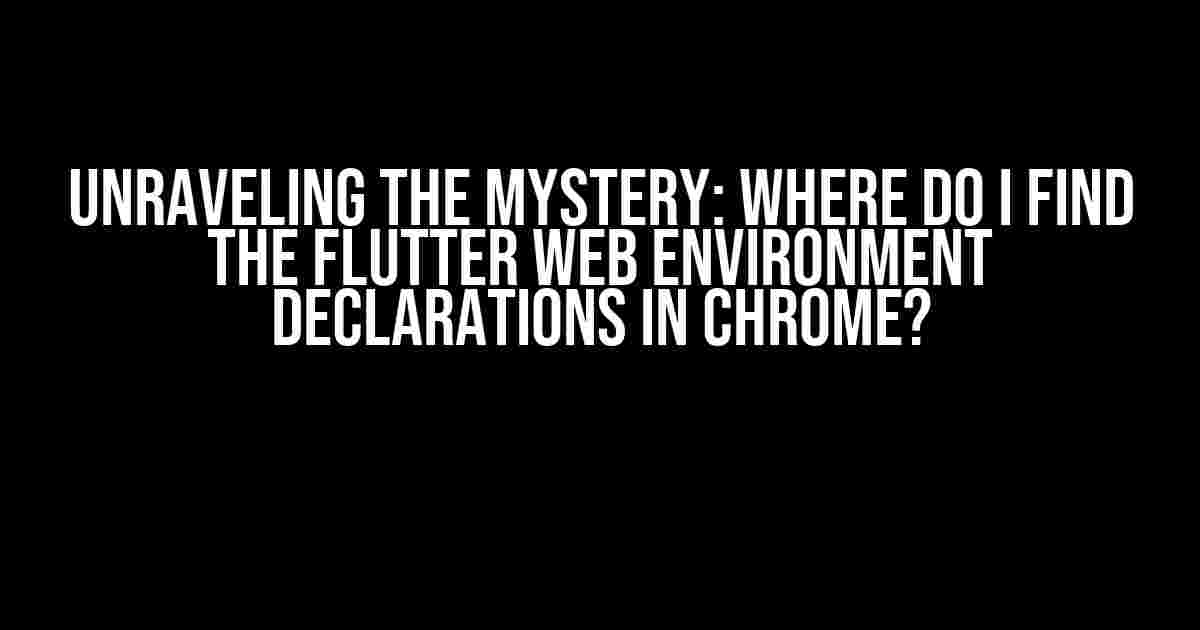If you’re a Flutter developer venturing into the world of web development, you might have stumbled upon this question: Where do I find the Flutter web environment declarations in Chrome? Fear not, dear developer, for we’re about to embark on a treasure hunt to uncover the secrets of Flutter web environment declarations in Chrome.
What are Flutter web environment declarations?
Before we dive into the “where,” let’s quickly cover the “what.” Flutter web environment declarations are essentially a set of configurations that allow your Flutter web app to interact with the web environment. These declarations are crucial for tasks like rendering, navigation, and debugging.
Think of them as a map that guides your Flutter app through the web landscape, ensuring a seamless user experience. But, where do you find these declarations in Chrome?
The Treasure Hunt Begins: Chrome DevTools
Open your Chrome browser and navigate to the website you’re developing with Flutter. Now, press Ctrl + Shift + I (Windows/Linux) or Cmd + Opt + I (Mac) to open the Chrome DevTools.
In the DevTools, switch to the Elements tab and press Ctrl + Shift + F (Windows/Linux) or Cmd + Shift + F (Mac) to open the Elements search. Type flutter in the search bar and press Enter.
This will highlight the Flutter-related elements in the HTML structure. Look for the head section, where you’ll find a script tag with a src attribute pointing to the Flutter framework.
<head> <script src="https://flutter.github.io/flutter.js"></script> ... </head>
Uncovering the Flutter Web Environment Declarations
Now, let’s get to the juicy part! In the same head section, you’ll find a script tag with an ID of flutter-environment-variables. This script tag contains the Flutter web environment declarations as a JSON object.
<head>
...
<script id="flutter-environment-variables" type="application/json">
{
"canvasKitUrl": "https://flutter.github.io/canvaskit/",
"flutterAssetsUrl": "assets/",
"initialRoute": "/",
...
}
</script>
...
</head>
Congratulations, dear developer! You’ve finally found the Flutter web environment declarations in Chrome.
What do these declarations do?
Now that you’ve uncovered the Flutter web environment declarations, let’s break down what each property does:
| Property | Description |
|---|---|
| canvasKitUrl | The URL of the CanvasKit library, which is used for rendering. |
| flutterAssetsUrl | The base URL for Flutter assets, such as images and fonts. |
| initialRoute | The initial route of your Flutter app. |
| … | … |
These declarations are essential for your Flutter web app to function correctly. They provide the necessary configuration for the Flutter framework to render your app.
Tweaking the Flutter Web Environment Declarations
What if you need to customize these declarations? Perhaps you want to use a different CanvasKit version or adjust the asset URL. Fear not, dear developer! You can modify these declarations to suit your needs.
Create a new file in your project’s root directory called web/index.html. This file will override the default Flutter web environment declarations.
<html>
<head>
<script id="flutter-environment-variables" type="application/json">
{
"canvasKitUrl": "https://my-custom-cdn.com/canvaskit/",
"flutterAssetsUrl": "my-assets/",
...
}
</script>
</head>
...
</html>
Now, when you run your Flutter web app, the custom declarations will take precedence over the default ones.
Conclusion
In conclusion, finding the Flutter web environment declarations in Chrome is a straightforward process. By exploring the Chrome DevTools and the HTML structure of your Flutter web app, you can uncover the secrets of these declarations.
Remember, these declarations are essential for your Flutter web app to function correctly. By understanding and tweaking them, you can customize your app to meet your needs.
So, the next time you venture into the world of Flutter web development, you’ll know exactly where to find the Flutter web environment declarations in Chrome.
Happy coding, and may the Flutter be with you!
- Flutter Web Environment Declarations: https://flutter.dev/docs/development/ui/flutter-for-web#environment-declarations
- Chrome DevTools: https://developers.google.com/web/tools/chrome-devtools
- Flutter Web Development: https://flutter.dev/web
Get ready to take your Flutter web development skills to the next level!Here are 5 questions and answers about “Where do I find the Flutter web environment declarations in Chrome?” in HTML format:
Frequently Asked Question
Get the answers to your burning questions about Flutter web environment declarations in Chrome!
Where do I find the Flutter web environment declarations in Chrome?
To find the Flutter web environment declarations in Chrome, navigate to chrome://inspect/#devices. Then, click on the “Elements” tab and press Ctrl + Shift + D (Windows/Linux) or Command + Shift + D (Mac) to open the DevTools in Debug mode. You’ll find the declarations in the “Elements” tab, under the “html” element.
What do I do if I don’t see the Flutter web environment declarations?
If you don’t see the declarations, ensure that you’re running your Flutter app in debug mode and that the DevTools are open. Also, check that you’ve enabled the “Debug mode” in the “Elements” tab. If you’re still having trouble, try restarting your Chrome browser or running your app on a different device.
Can I use Chrome DevTools to debug my Flutter web app?
Yes, you can use Chrome DevTools to debug your Flutter web app. With DevTools, you can inspect elements, debug code, and analyze performance issues. You can also use the “Elements” tab to inspect the HTML and CSS of your app and the “Console” tab to view logs and errors.
How do I switch between different Flutter web environments in Chrome?
To switch between different Flutter web environments in Chrome, navigate to chrome://inspect/#devices and click on the “Targets” tab. Then, select the environment you want to switch to from the list of available targets.
Are there any other tools I can use to debug my Flutter web app?
Yes, besides Chrome DevTools, you can use other tools like the Flutter Inspector, which provides a visual representation of your app’s widget tree, and the Flutter Debug Adapter, which allows you to debug your app using your preferred IDE or code editor.
